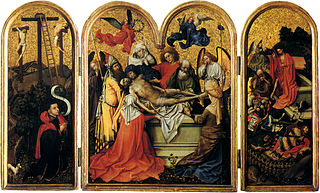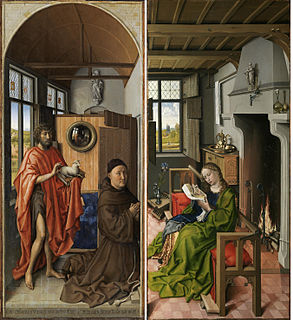 W
WRobert Campin, now usually identified with the Master of Flémalle, was the first great master of Flemish and Early Netherlandish painting. Campin's identity and the attribution of the paintings in both the "Campin" and "Master of Flémalle" groupings have been a matter of controversy for decades. Campin was highly successful during his lifetime, and thus his activities are relatively well documented, but he did not sign or date his works, and none can be confidently connected with him.
 W
WA Man and A Woman is the title sometimes used for a pair of oil and egg tempera on oak panel paintings attributed to the Early Netherlandish painter Robert Campin, completed c. 1435. Although usually considered pendants or companion pieces, they may also have been wings of a since dismantled diptych. The latter theory is supported by the fact that the reverse of both panels are marbled, indicating that they were not intended to be hung against a wall.
 W
WThe Marriage of the Virgin or also known as The Betrothal of the Virgin, is a c.1420-1430 oil on oak painting by Robert Campin. The painting was intended to be a metaphor, primarily focused on the transition from the Old to the New Testament, which is expressed through iconography and disguised symbolism. It entered into the Spanish royal collection at El Escorial in 1584. It was later obtained by Prado Museum, where it continues to reside. This work by Robert Campin is one of his earliest and was previously attributed to Roger Van der Weyden. The work presents the betrothing of Mary and Joseph in front of an incomplete Gothic portal. In the left background, there is a Romanesque building that presents the Miracle of the Flowering Rod. This is the event in which Joseph was chosen to be wed to Mary. Presented at the top of the building are stain glassed windows which depict scenes from the Hebrew Bible thought to be Old Testament stories, such as Abraham's sacrifice of Isaac. The overall objective of Robert Campins "Marriage of the Virgin" was to symbolize the transition of Old Dispensation to the New Dispensation.
 W
WThe Mérode Altarpiece is an oil on oak panel triptych, now in The Cloisters, in New York City. It is unsigned and undated, but attributed to Early Netherlandish painter Robert Campin and an assistant. The three panels represent, from left to right, the donors kneeling in prayer in a garden, the moment of the Annunciation to Mary, which is set in a contemporary, domestic setting, and Saint Joseph, a carpenter with the tools of his trade. The many elements of religious symbolism include the lily and fountain, and the Holy Spirit represented by the rays of light coming through from the left hand window.
 W
WNativity is a 1420 panel painting by the Early Netherlandish painter Robert Campin. As often, the moment shown is the adoration of the shepherds. Harshly realistic, the Child Jesus and his parents are shown in poverty, the figures crowded in a small structure, with broken-down walls, and a thatched roof with a hole, the single space shared with animals. In this Campin abandons the traditional narrative.
 W
WPortrait of a Fat Man are names given to two near-identical oil on panel paintings attributed to the Early Netherlandish artist Robert Campin. Both versions are dated c. 1425, and are in the Gemäldegalerie, Berlin and Museo Thyssen-Bornemisza, Madrid.
 W
WThe Seilern Triptych, variously dated c. 1410-15 or c 1420-25 is a large oil and gold leaf on panel, fixed winged triptych altarpiece generally attributed to the Early Netherlandish painter Robert Campin. It is the earliest of two known triptychs attributed to him., although the outer wing panels paintings are lost. The work details the events of Christ's passion; with iconography associated with the liturgy of Holy Week. The panels, which should be read from left to right, detail three stations of the cycle of the Passion of Jesus; the crucifixion, the burial and the resurrection.
 W
WThe Werl Triptych is a triptych altarpiece completed in Cologne in 1438, of which the center panel has been lost. The two remaining wings are now in the Prado in Madrid. It was long attributed to the Master of Flémalle, now generally believed to have been Robert Campin, although this identity is not universally accepted. Some art historians believe it may have been painted as a pastiche by either the workshop or a follower of Campin or the Master of Flémalle.